Abstract
Uptake of 35S-hydroxyethylthiazole (4-methyl-5-hydroxyethylthiazole) by Escherichia coli intact cells was studied. Hydroxyethylthiazole was taken up in the presence and absence of glucose at the same rate. The uptake was almost proportional to a hydroxyethylthiazole concentration gradient up to 0.1 mM with no tendency of saturation, and reached a steady state within 2 min. When the cells were treated with 1 mM N-ethylmaleimide, about 50% inhibition of hydroxyethylthiazole uptake was observed. Hydroxyethylthiazole uptake was stimulated by the addition of hydroxymethylpyrimidine (2-methyl-4-amino-5-hydroxymethylpyrimidine), and this effect was further enhanced in the presence of glucose. For full activation of hydroxyethylthiazole uptake, 1 μM hydroxymethylpyrimidine was necessary in the presence of glucose. The rate of hydroxyethylthiazole uptake was almost linear up to 60 min in the presence of hydroxymethylpyrimidine and glucose. Hydroxymethylpyrimidine monophosphate and its pyrophosphate could not stimulate the uptake. Thiamine and 2-amino-hydroxyethylthiazole were inhibitory on hydroxyethylthiazole uptake in the presence of hydroxymethylpyrimidine and glucose. N-ethylmaleimide and 2, 4-dinitrophenol were also inhibitory. No stimulatory effect of hydroxymethylpyrimidine on hydroxyethylthiazole uptake was observed in mutant cells lacking either thiaminephosphate pyrophosphorylase or hydroxymethylpyrimidine monophosphate kinase. The possibility of direct participation of thiamine-synthesizing enzymes in hydroxyethylthiazole uptake was discussed.
Full text
PDF
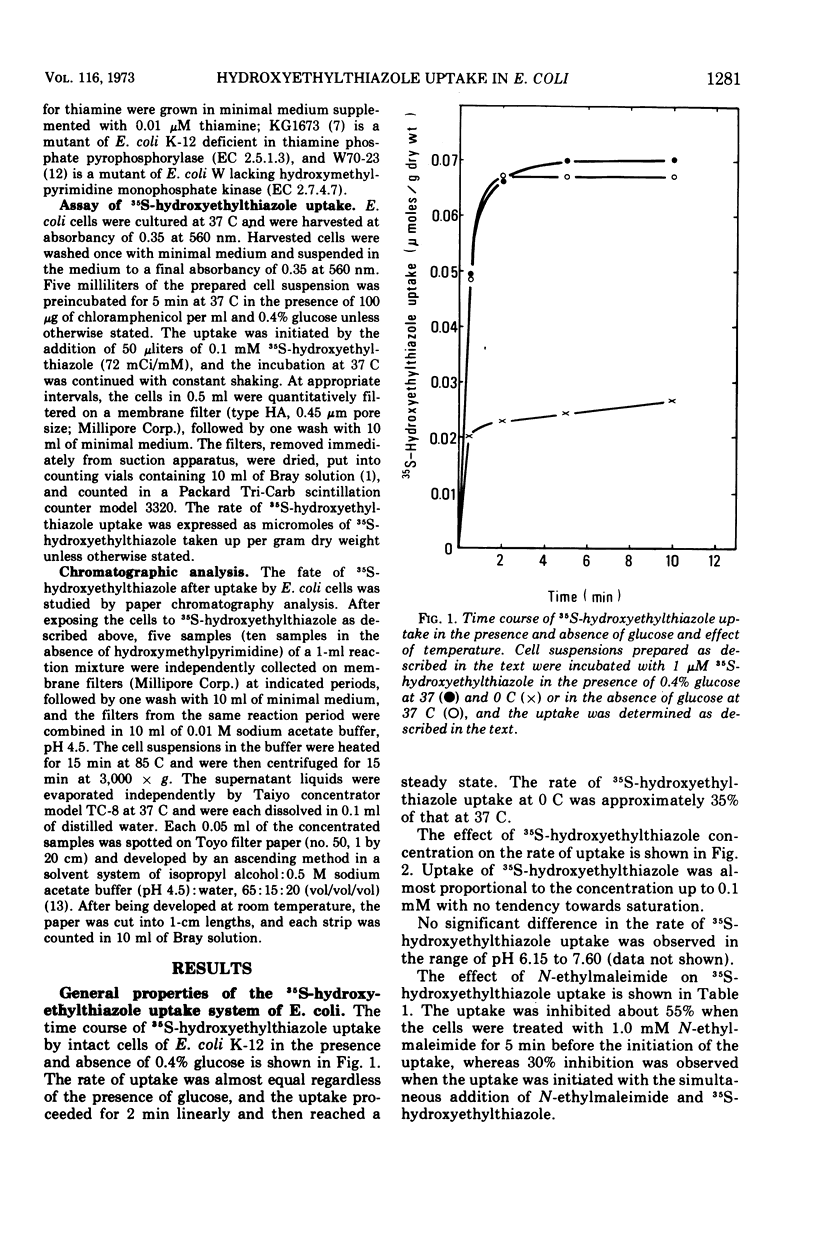
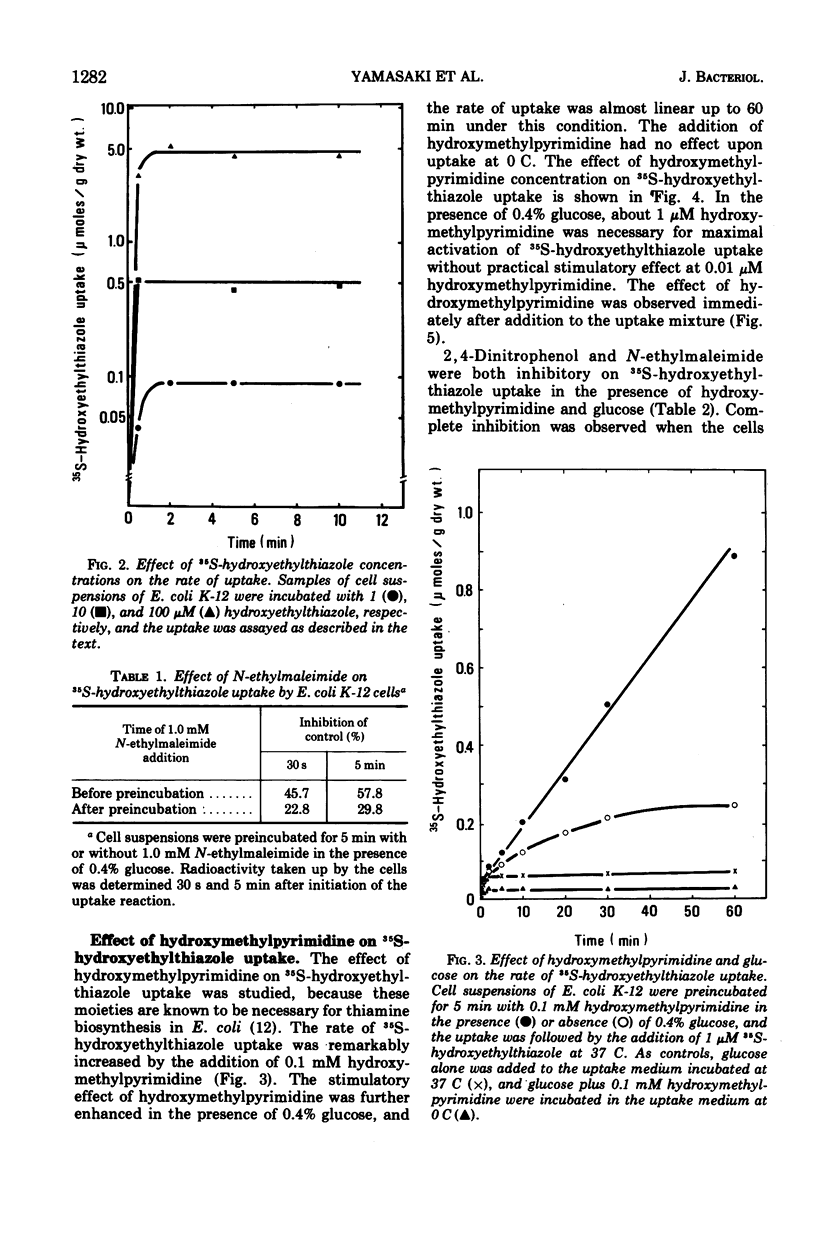

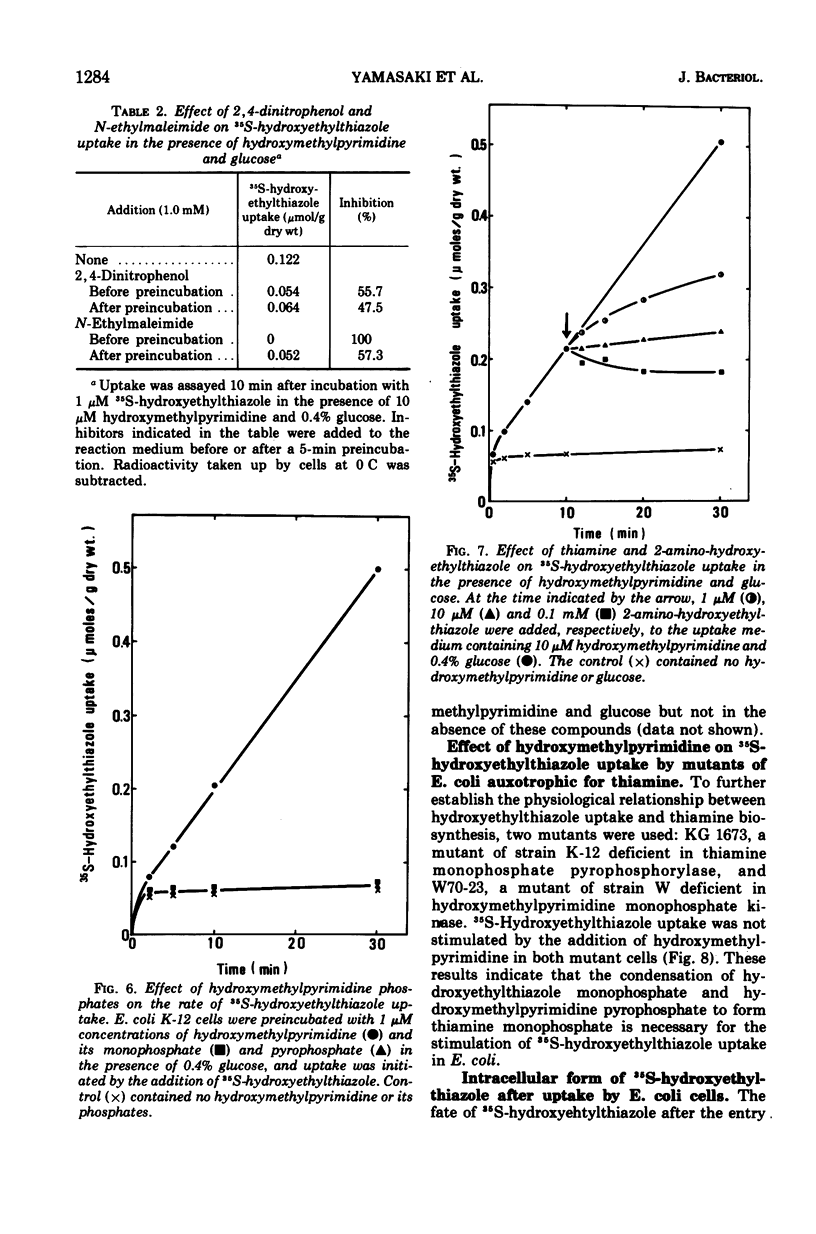
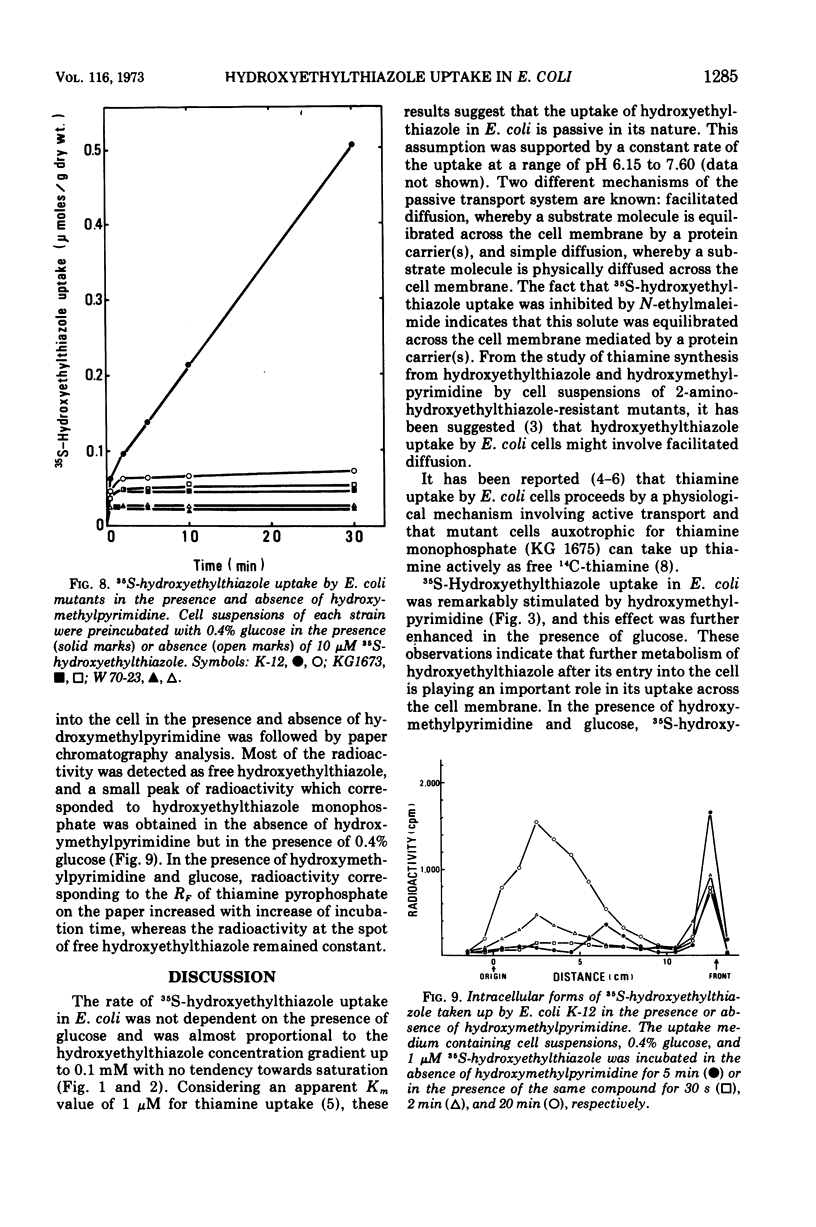
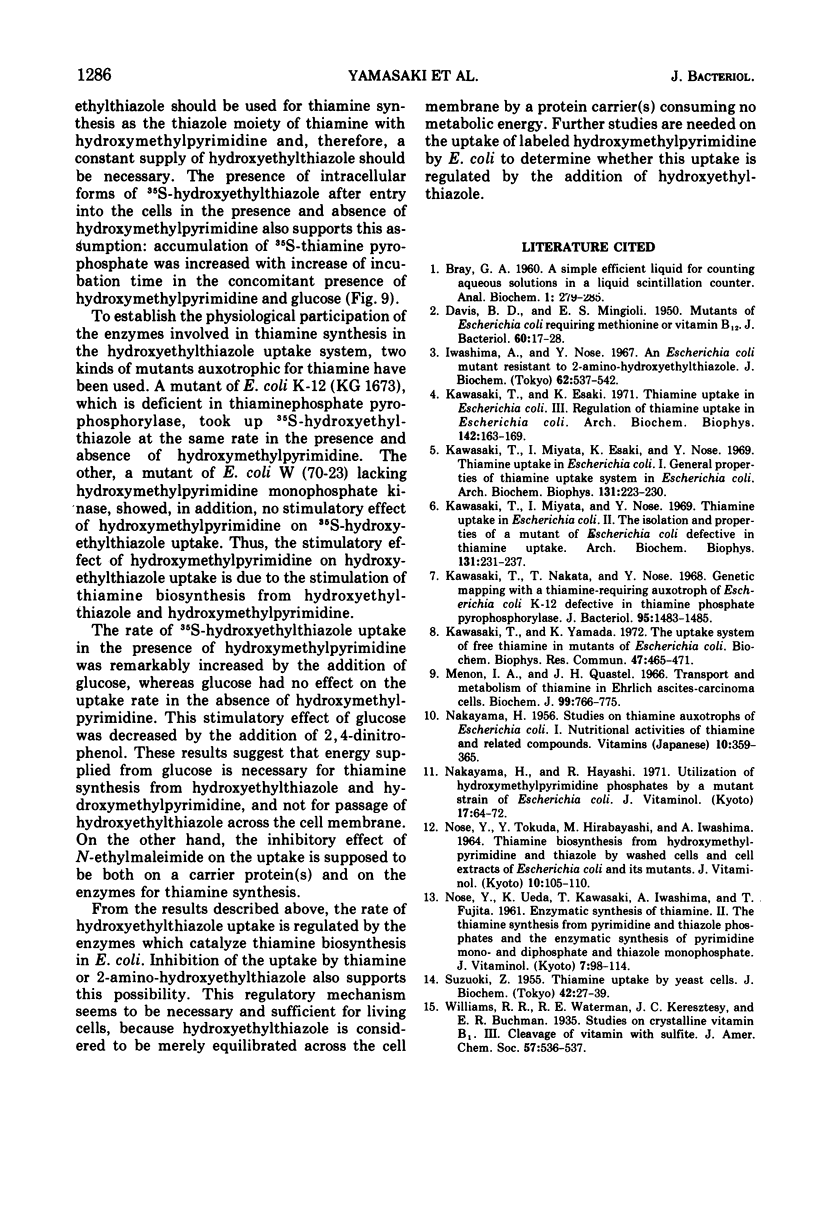
Selected References
These references are in PubMed. This may not be the complete list of references from this article.
- DAVIS B. D., MINGIOLI E. S. Mutants of Escherichia coli requiring methionine or vitamin B12. J Bacteriol. 1950 Jul;60(1):17–28. doi: 10.1128/jb.60.1.17-28.1950. [DOI] [PMC free article] [PubMed] [Google Scholar]
- Iwashima A., Nose Y. An Escherichia coli mutant resistant to 2-amino-hydroxyethylthiazole. J Biochem. 1967 Nov;62(5):537–542. doi: 10.1093/oxfordjournals.jbchem.a128703. [DOI] [PubMed] [Google Scholar]
- Kawasaki T., Esaki K. Thiamine uptake in Escherichia coli. 3. Regulation of thiamine uptake in Escherichia coli. Arch Biochem Biophys. 1971 Jan;142(1):163–169. doi: 10.1016/0003-9861(71)90271-2. [DOI] [PubMed] [Google Scholar]
- Kawasaki T., Miyata I., Esaki K., Nose Y. Thiamine uptake in Escherichia coli. I. General properties of thiamine uptake system in Escherichia coli. Arch Biochem Biophys. 1969 Apr;131(1):223–230. doi: 10.1016/0003-9861(69)90125-8. [DOI] [PubMed] [Google Scholar]
- Kawasaki T., Nakata T., Nose Y. Genetic mapping with a thiamine-requiring auxotroph of Escherichia coli K-12 defective in thiamine phosphate pyrophosphorylase. J Bacteriol. 1968 Apr;95(4):1483–1485. doi: 10.1128/jb.95.4.1483-1485.1968. [DOI] [PMC free article] [PubMed] [Google Scholar]
- Kawasaki T., Yamada K. The uptake system of free thiamine in mutants of Escherichia coli. Biochem Biophys Res Commun. 1972 Apr 28;47(2):465–471. doi: 10.1016/0006-291x(72)90737-1. [DOI] [PubMed] [Google Scholar]
- Menon I. A., Quastel J. H. Transport and metabolism of thiamine in Ehrlich ascites-carcinoma cells. Biochem J. 1966 Jun;99(3):766–775. doi: 10.1042/bj0990766. [DOI] [PMC free article] [PubMed] [Google Scholar]
- NOSE Y., TOKUDA Y., HIRABAYASHI M., IWASHIMA A. THIAMINE BIOSYNTHESIS FROM HYDROXYMETHYLPYRIMIDINE AND THIAZOLE BY WASHED CELLS AND CELL EXTRACTS OF ESCHERICHIA COLI AND ITS MUTANTS. J Vitaminol (Kyoto) 1964 Jun 10;10:105–110. doi: 10.5925/jnsv1954.10.105. [DOI] [PubMed] [Google Scholar]
- NOSE Y., UEDA K., KAWASAKI T., IWASHIMA A., FUJITA T. Enzymatic synthesis of thiamine. II. The thiamine synthesis from pyrimidine and thiazole phosphates and the enzymatic synthesis of pyrimidine mono- and diphosphate and thiazole monophosphate. J Vitaminol (Kyoto) 1961 Jun 10;7:98–114. [PubMed] [Google Scholar]
- Nakayama H., Hayashi R. Utilization of hydroxymethylpyrimidine phosphates by a mutant strain of Escherichia coli. J Vitaminol (Kyoto) 1970 Jun 10;17(2):64–72. doi: 10.5925/jnsv1954.17.64. [DOI] [PubMed] [Google Scholar]


